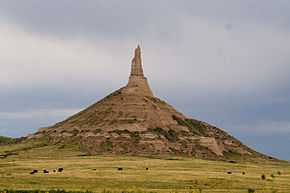Chimney Rock National Historic Site
- This article is about the landmark in Nebraska along the historic Oregon Trail and Mormon Pioneer National Historic Trail; for other uses, see Chimney Rock (disambiguation).
| Chimney Rock National Historic Site | |
|---|---|
|
IUCN category III (natural monument or feature) | |
|
Chimney Rock in 1904 | |
 Chimney Rock | |
| Location | Morrill County, Nebraska, USA |
| Nearest city | Bayard, Nebraska |
| Coordinates | 41°42′13.24″N 103°20′53.58″W / 41.7036778°N 103.3482167°WCoordinates: 41°42′13.24″N 103°20′53.58″W / 41.7036778°N 103.3482167°W |
| Area | 83 acres (34 ha) |
| Designated | August 9, 1956 |
| Operator | Nebraska State Historical Society |

Chimney Rock is a prominent geological rock formation in Morrill County in western Nebraska. Rising nearly 300 feet (91 m) above the surrounding North Platte River valley, the peak of Chimney Rock is 4,226 feet (1,288 m) above sea level.[1] During the middle 19th century it served as a landmark along the Oregon Trail, the California Trail, and the Mormon Trail, which ran along the north side of the rock. It is visible for many miles from the east along U.S. Route 26.
History
The first recorded mention of "Chimney Rock" was in 1827 by Joshua Pilcher. Pilcher had journeyed up the Platte River valley to the Salt Lake rendezvous of the Rocky Mountain fur trappers. The first non-natives to see the pillar were probably the Astorians of Robert Stuart in their eastern journey from the Pacific Ocean in 1813. This marker of the plains was recorded in many journals after this time.[2] The name "Chimney Rock" probably originated from early fur traders.[3] It went through a variety of names before becoming Chimney Rock such as Chimley Rock, Chimney Tower, and Elk's Peak.[3]
Based on sketches, paintings, written accounts, and the 1897 photograph by Darton, Chimney Rock was taller when it was first seen by settlers, but has been reduced in height since then by erosion and lightning.
Geology
The pillar consists primarily of Brule clay interlayered with volcanic ash and Arikaree sandstone. The harder sandstone layers near the top have protected the pillar since it broke away from the retreating cliff line to the south.[4] Chimney Rock rises approximately 286 feet (87 m) above its surroundings.[1]
Today
Chimney Rock was designated a National Historic Site on August 9, 1956[5] and is a National Park Service affiliated area. It is maintained and operated by the Nebraska State Historical Society. Chimney Rock and Independence Rock further west are probably the most famous features along the Oregon Trail. It is located 20 miles southeast of Scotts Bluff National Monument, on Nebraska Route 92 [6]
The Ethel and Christopher J. Abbot Visitor Center features museum exhibits and a video about pioneers and the migrations in the West, as well as a gift shop.[7]
On March 1, 2006, the Nebraska State Quarter was released. The quarter features a covered wagon headed west past Chimney Rock, memorializing Nebraska's role in westward migration.
See also
- Landmarks of the Nebraska Territory
- Courthouse and Jail Rocks
- Scotts Bluff National Monument
- Butte
- Nebraska Sandhills
References
- ↑ 1.0 1.1 "Chimney Rock, Nebraska". Peakbagger.com. Retrieved 2011-03-25.
- ↑ Chimney Rock National Historic Site, Nebraska, National Park Service, 1964
- ↑ 3.0 3.1 "Chimney Rock History"
- ↑ "Chimney Rock". Nebraska State Historical Society.
- ↑ "More About Chimney Rock National Historic Site". Nebraska State Historical Society.
- ↑ "Chimney Rock, Nebraska". TakeMyTrip.com.
- ↑ "Chimney Rock National Historic Site". Nebraska State Historical Society.
External links
| Wikimedia Commons has media related to Chimney Rock National Historic Site. |
- Chimney Rock National Historic Site operated by the Nebraska State Historical Society
- Chimney Rock National Historic Site. StateParks.com.
| ||||||||||||||||||||||||||
